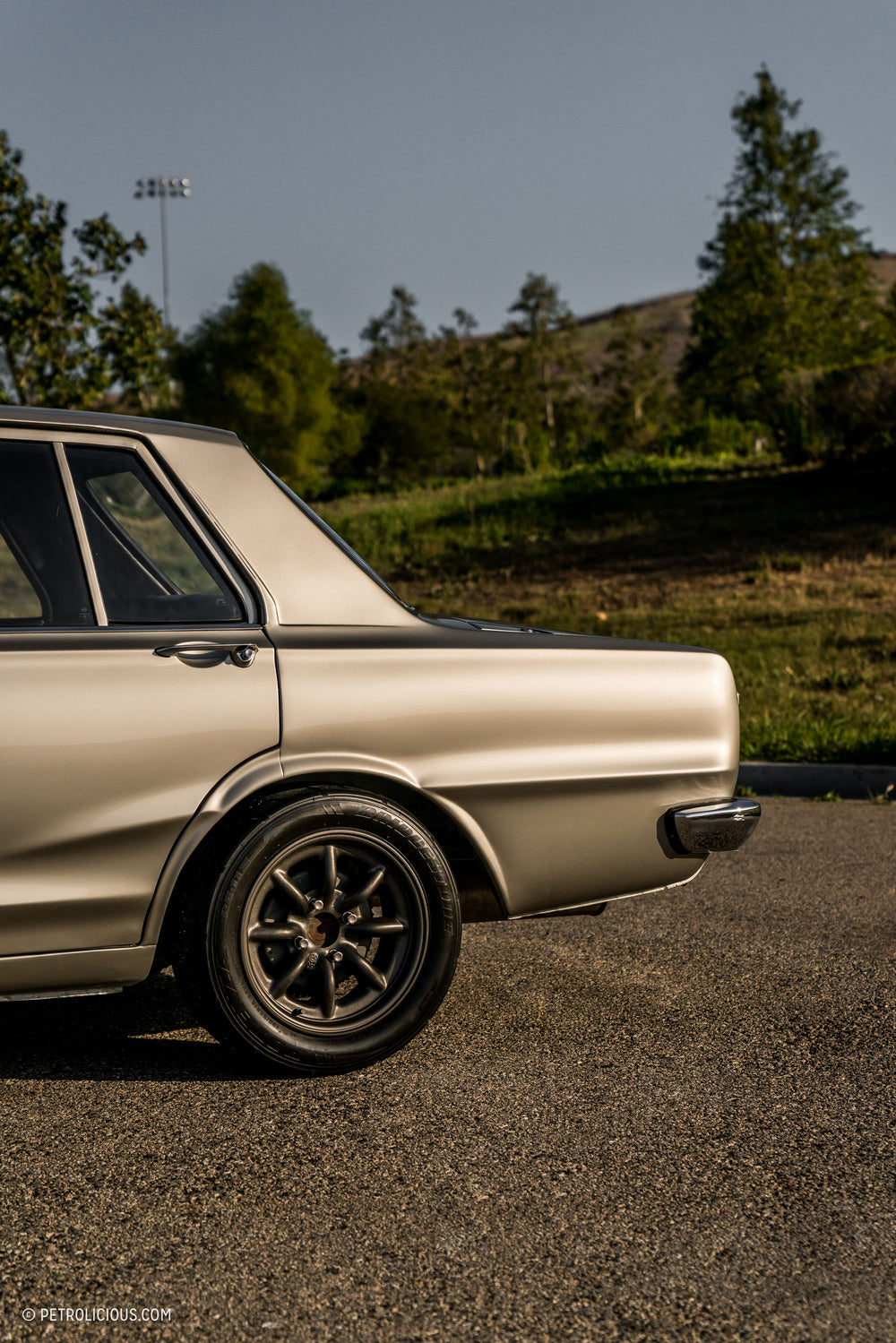Sitting parked, this boxy four-door could easily be overlooked. But retrain your eye and go in for a closer look, as this 1969 Nissan Skyline has much more to share than your average Japanese sedan.
Take a stroll around and soak up the furrowed brow and the sharp lines that shape this sharp body. A lower body flare runs into the rear wheel only to be picked up above and carried into the rear fender, like the slash from a katana. Slowly but surely, if you know what to look for, you’ll realize that this is one very special import. The fender-mounted side mirrors or the stainless-steel exhaust tip poking out from the rear fender hint at its subtle but very present aggression.




I met up with SoCal car collector Eric from Original Rare on a quiet cul-de-sac in Orange County, California on a Sunday evening, and as I photographed his pristine piece of JDM machinery, Eric was eager to explain what I was looking at; this car was directly derived from motorsport, and it is the definition of the word “sleeper."
According to Eric, and I have to agree, the current generation of GT-R fans are largely unaware of the storied motorsport history of the badge before the R32 era, and even less know that the first GT-R was a sedan.





The Skyline badge you see on the car didn’t originate from Nissan either. The Prince Motor Company coined the moniker in 1957, more than a decade before the first Skyline GT-R rolled out from Nissan Motor Corporation factory doors. Prince produced a range of luxury sedans, station wagons, and sport coupes at the time, and the Prince Skyline Sport was designed by Giovanni Michelotti, one of the most iconic designers of the 20th century, having created concepts for countless Ferrari and Maserati vehicles.




But we aren’t concerned with his Italian portfolio today. In the 1960s, motorsport was gaining popularity in Japan with Honda involved in developing the Suzuka Circuit and Mitsubishi doing the same with Fuji Speedway. Prince witnessed the increasing popularity of motorsport all around Japan and wanted a piece of the pie to boost its sales, so in 1964, Prince entered their latest Skyline, the S54 2000 GT, into the Japan Grand Prix (not to be confused with the F1 race) hoping to prove the potential of the car’s straight-six in a competition setting. Much to the surprise of Prince engineers, a privateer team entered a faster and more agile Porsche 904. So while the mid-engine Porsche 904 took first place, the Skyline sedans were still able to hold their own, taking 2nd through 6th place.



Noting the benefits of the Porsche prototype, specifically the mid-engine design, Prince engineers immediately went to work on a mid-engine race car of their own named the R380. Due to management issues in 1965, the Japan Grand Prix was canceled, but Prince made a triumphant return in 1966.
The race moved from Suzuka Circuit to Fuji Speedway in 1966 and Prince hoped to finally conquer the podium with the R380. Porsche, however, had also been hard at work developing a new race car, the 906, that once again ratcheted up the formula with more power, less weight, and better handling than their retired 904. Nevertheless, by the time the checkered flag dropped the more reliable Prince R380s took first and second position, cementing the small manufacturer’s place in the performance-car world.




Impressed with the R380’s racing success, Nissan merged with Prince in 1967 in a strategic partnership to compete with the larger Toyota Motor Corporation. The Prince organization remained in existence inside Nissan, but the Prince name was dropped. In the summer of 1968, the new C10-series Skylines were launched under the Nissan marque. Nissan enhanced the original Prince design with more aggressive features in nearly every aspect, while maintaining the Prince’s boxy body. It was nicknamed “Hakosuka” by the public, loosely translated as “Boxy Skyline.”
The autumn of 1968 marked Nissan’s introduction of the Skyline 2000 GT-R sedan (the PGC10 internally) at the Tokyo Motor Show. In February 1969, the GT-R sedan officially launched to the public and was advertised alongside the R380 race car to showcase the Skyline’s racing roots. Two years later in 1971, the Skyline GT-R coupe (the KPGC10) became available, the one everyone thinks of when you tell them about the “first GT-R.”


The Hakosuka GT-Rs are powered by the S20 engine, which is a slightly detuned version of the engine from the R380’s inline-six, featuring dual overhead cams with four valves per cylinder that let it scream all the the way to 7,000RPM. Besides capitalizing on the success they’d already had on track, Nissan created the GT-R in order to win races itself, and they were hugely successful with the sedan, scoring 33 straight victories, and the GT-R coupe stretching that to 50 total victories in their entered events. Just 832 GT-R sedans were produced, making them rarer than the coupes (of which 1,197 examples were produced).


Combining the motorsport history and the timeless mature design attracts modern collectors like Eric, but these cars were never officially brought stateside by Nissan. An this car is brand new to US soil, having just arrived at the beginning of this year. Eric plans to keep the car as original as possible too, with a few minor modifications like the Nardi steering wheel; he’s not a fan of the slammed and tuned style that many other Hakosuka owners prefer. Just letting the high-pitched carbureted S20 wail to redline is more than enough.



Without knowing how many other four-door GT-R sedans have been imported, and with Hakosuka GT-R clones flooding the market here and abroad, this could very well be the only original example in America.
























































